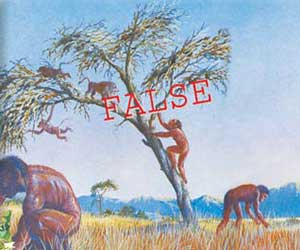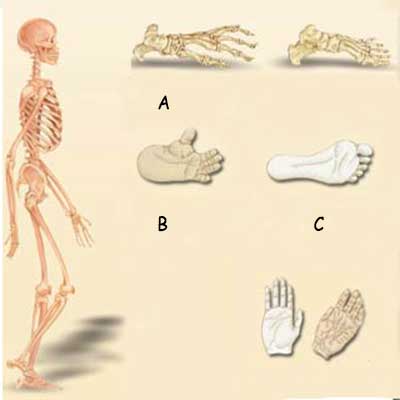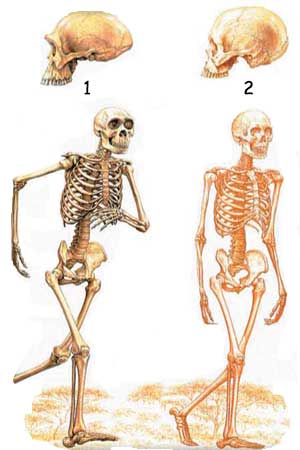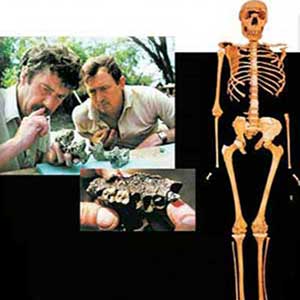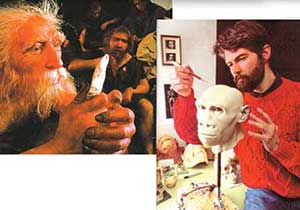Bigotry: The Dark Danger
A Definitive Reply to Evolutionist Propaganda

DOWNLOAD THE BOOK
CHAPTERS OF THE BOOK
- Introduction
- A Series of Blunders Regarding Monkey Intelligence
- The Smuggling Incident National Geographic TV Declined To Cover
- National Geographic TV's Undersea Fairy Tales
- Tall Tales From The National Geographic Channel
- Tales of Transformation from National Geographic Television
- The “Mitochondrial Eve” Deception On The Discovery Channel
- The Dino-Bird Fantasy On The Discovery Channel
- Errors Concerning Human Intelligence From The Discovery Channel
- The Discovery Channel's Spider Dilemma
- Evolutionst Propaganda on The History Channel
- The History Channel's Darwinist and Atheist Propaganda
- New Scientist’s Latest Myth:"Hiccups are a Legacy from Evolution"
- New Scientist’s “ Evolution with Climate” Error
- Paul Davies' Desperate Case for a “Multiverse”
- Evolutionary Tall Tales From The BBC -I-
- Evolutionary Tall Tales From The BBC –II-
- Evolutionary Tall Tales From The BBC –III-
- The BBC's Functionless Tissue Error In Its Documentary The Human Body
- BBC's Evolution of The Human Brain Error
- The Evolutionist Deceptions in the Documentary the Shape of Life
- Evolutionist Deceptions Continue with the Arthropods in the Shape of Life Documentary
- The Evolutionists are Still Struggling with the Same Dilemma: The Origin of Flight
- New Fossil Fish Discoveries Pose a New Dilemma for the Theory of Evolution
- The Latest Version of Baseless Evolutionist Scenarios in Scientific American: Nutrition
- Time Writer M. Lemonick's Mind-Body Error
< <
5 / total: 26
Tall Tales From The National Geographic ChannelThe documentary Humans: Who Are We?, one of the documentaries being broadcast on the National Geographic Channel (NGC), consists of the best-known scenarios of the myth of evolution. The scientific errors and deceptions in the documentary are explained below. The NGC's Contradictions and the Larmarckian View of Evolution
In the documentary on the NGC, there is first of all an address by the anthropologist Ian Tattersall. Among his first statements is the idea, "Human evolution did not happen as the result of needs, it was entirely coincidental." Yet the needs which might have caused ape-men to evolve into human beings are then described several times in the minutes which follow. This is one of the most obvious contradictions in the whole program. Actually, this is a contradiction experienced by many evolutionists, not just the NGC or Ian Tattersall. In order to shed more light on this subject, let us summarize the difference between the concepts of "evolution as a response to need" and "evolution as the result of chance alone" (even though both are in fact unscientific fairy tales). Before Darwin, another important figure put forward an evolutionary model on the subject of the origin of living things: the French biologist Jean-Baptiste Lamarck. Lamarck's claim was rather different from the contemporary evolutionist view. In his opinion, requirements or needs gave rise to their own organs. Let us illustrate Lamarckism with the example of the giraffe's neck. According to this theory, the necks of the first giraffes were the same length as those of deer or gazelles. However, giraffes experiencing food shortages wanted to be able to reach the rich sources of food in the upper levels of trees. A need was thus born. As a result of that need, the necks of giraffes wishing to reach up into the tops of trees grew longer. Lamarckism based this claim on the thesis of "inheritance of acquired traits." In other words, the giraffe which had tried to reach up to trees' highest levels throughout its life should be able to hand this characteristic on to its young. Yet, with the discovery of the laws of genetics, it was seen that acquired traits could not actually be inherited at all.
As a result, Lamarckism had been invalidated by science by the beginning of the twentieth century. Yet, evolutionists continued to put forward Lamarckian views between the lines. While fiercely criticizing Lamarckism on the one hand, their scenarios regarding the origins of living things still bore powerful traces of it. The myth of front legs' remaining free in order to make tools, making man a bipedal (two-footed) creature, the claim that Neanderthal man evolved in order to be able to live in cold climates, as put forward by the NGC, and that Australopithecus evolved in order to adapt to its environment as the thick forests thinned out—all of these rest on the assumption of evolution out of need. The reason why evolutionists employ Lamarckian expressions, on the one hand, while fiercely criticizing the thesis, on the other, is this: According to the theory of evolution, in order for a monkey to be able to stand on two legs, for instance, it needs to be exposed to mutations that will bring about such a sensitive change in its skeleton, and which furthermore will not cause it any damage. This is in any case a scenario that cannot possibly happen. It would require a chance mutation to come about at just the very time when the living thing in question has need of it, and this would have to occur many times in individuals of the same species, bringing about a little more development each time. The impossibility of this scenario just reinforces the absurdity of the whole concept of evolution. On the surface, evolutionists refuse to say, "there was evolution out of need," but underneath, they actually support that idea. Australopithecus was a Species of Ape, and was not Bipedal
According to the NGC, the species known as Australopithecus was the ancestor of the first man to walk upright. Yet that claim is not correct. All of the Australopithecus species are extinct apes that resemble the apes of today. Their cranial capacities are the same or smaller than those of the chimpanzees of our day. There are projecting parts in their hands and feet that they used to climb trees, just like in today's chimpanzees, and their feet are built for grasping to hold onto branches. Australopithecus specimens are short (130 cm, maximum) and, just as in modern apes, the males are much bigger than the females. Many other characteristics—such as the details in their skulls, the closeness of their eyes, their sharp molar teeth, their mandibular structure, their long arms, and their short legs—constitute evidence that these creatures were no different from today's apes. NGC's claim that Australopithecus walked upright is a view that has been held by paleoanthropologists like Richard Leakey and Donald C. Johanson for decades. Yet many scientists who have carried out a great deal of research on the skeletal structures of Australopithecus have proved the invalidity of that argument. Extensive research done on various Australopithecus specimens by two world-renowned anatomists from England and the USA, Lord Solly Zuckerman and Prof. Charles Oxnard, showed that these creatures did not walk upright in the human manner, and had exactly the same movements as modern apes. Having studied the bones of these fossils for a period of 15 years thanks to grants from the British government, Lord Zuckerman and his team of five specialists reached the conclusion that Australopithecus was only an ordinary species of ape, and was definitely not bipedal—this even though Zuckerman is an evolutionist himself.1 Correspondingly, Charles E. Oxnard, who is another evolutionary anatomist famous for his research on the subject, also likened the skeletal structure of Australopithecus to that of modern orangutans.2
Probably the most important study demonstrating that Australopithecus could not have been bipedal came in 1994 from the research anatomist Fred Spoor and his team at the University of Liverpool, England. This group conducted studies in the inner ear of fossilized Australopithecus specimens. In the inner ears of human beings and other complex living beings, there is an organ named the "cochlea" that determines the position of the body in relation to the ground. The function of this organ, which maintains balance in human beings, is the same as the "gyroscope," which maintains correct flight attitude in airplanes. Fred Spoor investigated the involuntary balance mechanism found in this "snail-shell" like organ, and his findings showed conclusively that Australopithecus was quadrupedal (four legged).3 This means Australopithecus is an extinct ape species and has no relation with human beings.
That Australopithecus cannot be counted an ancestor of man has recently been accepted by evolutionist sources. The famous French popular-science magazine, Science et Vie, made the subject the cover of its May 1999 issue. Under the headline "Adieu Lucy" ("Goodbye, Lucy"—Lucy being the most important fossil example of the species Australopithecus afarensis), the magazine reported that apes of the species Australopithecus would have to be removed from the human family tree. In this article, based on the discovery of another Australopithecus fossil known simply as St W573, the following sentences appear:
Another important discovery concerning Australopithecus is the realization that this creature's hands were used for walking, just like those of present-day apes. Apes employ a four-legged mode of walking in which they lean on the knuckles of their fingers. Known as "knuckle walking," this is one of the major structural differences between apes and men. The skeletal studies performed in 2000 on Lucy by two evolutionist scientists called B. G. Richmond and D. S. Strait, resulted in a conclusion that astonished the two evolutionists: Lucy's hand possessed a four-legged "knuckle walking structure," just like those of the apes of today. Strait's comment in an interview regarding this discovery, the details of which were covered by the journal Nature, is striking: "I walked over to the cabinet, pulled out Lucy, and—shazam!—she had the morphology that was classic for knuckle walkers."5
Homo erectus was a Human Race, not an Ape-Man
In the NGC documentary Homo erectus is portrayed as a half-ape, half-man creature which walked upright and tried to speak by making peculiar noises. The fact is, however, that Homo erectus was a human race, with no ape characteristics at all. There is no difference between the Homo erectus skeleton and that of modern man. The primary reason for evolutionists' defining Homo erectus as "primitive" is the cranial capacity of its skull (900-1,100 cc), which is smaller than the average modern man, and its thick eyebrow projections. However, there are many people living today in the world who have the same cranial capacity as Homo erectus (pygmies, for instance) and other races have protruding eyebrows (Native Australians, for instance). It is a commonly agreed-upon fact that differences in cranial capacity do not necessarily denote differences in intelligence or abilities. Intelligence depends on the internal organization of the brain, rather than on its volume.6 The fossils that have made Homo erectus known to the entire world are those of Peking man and Java man in Asia. However, in time it was realized that these two fossils are not reliable. Peking Man consists of some elements made of plaster whose originals have been lost, and Java Man is "composed" of a skull fragment plus a pelvic bone that was found meters away from it with no indication that these belonged to the same creature. This is why the Homo erectus fossils found in Africa have gained such increasing importance. The most famous of the Homo erectus specimens found in Africa is the fossil of the "Turkana Boy," which was found near Lake Turkana in Kenya. It is confirmed that the fossil was that of a 12-year-old boy, who would have been 1.83 meters tall in adolescence. The upright skeletal structure of the fossil is no different from that of modern man. The American paleoanthropologist Alan Walker said that he doubted that "the average pathologist could tell the difference between the fossil skeleton and that of a modern human." Concerning the skull, Walker wrote that he laughed when he saw it because "it looked so much like a Neanderthal."7 Since Neanderthals are a modern human race, Homo erectus is also a modern human race.
Even the evolutionist Richard Leakey states that the differences between Homo erectus and modern man are no more than racial variance:
Professor William Laughlin from the University of Connecticut made extensive anatomical examinations of Inuits and the people living on the Aleutian islands, and noticed that these people were extraordinarily similar to Homo erectus. The conclusion Laughlin arrived at was that all these distinct races were in fact different races of Homo sapiens (modern man):
There is a huge gap between Homo erectus, a human race, and the apes that preceded Homo erectus in the "human evolution" scenario (Australopithecus, Homo Habilis, and Homo rudolfensis). This means that the first men appeared in the fossil record suddenly and without any prior evolutionary history. NGC Fairy Tales Appropriate for Bedtime Programs
The scientists expressing their views on NGC told the viewer stories, relying on their imaginations instead of scientific findings. Almost the entire length of the documentary consisted of such story-telling. The most striking example of this appeared in the section about Homo erectus' power of speech. People enjoying the status of scientists gave their views, in all seriousness, regarding what members of the Homo erectus species talked about amongst themselves. According to the anthropologist Dr. Steven Mithen, when Homo erectus spoke, they engaged in gossip! Another evolutionist scientist claimed that rather than gossiping, they talked about serving food! Neither was this the limit of the stories related on NGC. These scientists were also somehow aware of a great many more details, such as what one migrating ape-man thought, and the fixed-thoughts possessed by yet another one. The odd thing is that these Darwinist mental gymnastics, devoid of any scientific foundations, were portrayed to the viewer as scientific fact. The NGC's Visual Evolutionist Propaganda
Throughout the documentary on NGC, images of half-ape, half-man creatures hunting on the African savannah, eating, and migrating were shown. Those who imagined the NGC to be a scientific institution would have been deceived into thinking that these creatures were based on scientific evidence. The fact is, however, that just like the information provided, these images had been prepared solely on the basis of evolutionists' imaginations and the abilities of various artists. Reconstructions are one of evolutionists' most important propaganda tools. The ape-man models and drawings seen in such documentaries as this, and in evolutionist magazines and newspapers, are termed reconstructions. These are totally unscientific, and in no way reflect the truth, because it is impossible to obtain any information about a living thing's soft tissues on the basis of fossils. Reconstructions based on bone remains can only reveal the most general characteristics of the creature, since the really distinctive morphological features of any animal are soft tissues, which quickly vanish after death. Therefore, due to the speculative nature of the interpretation of the soft tissues, the reconstructed drawings or models become totally dependent on the imagination of the person producing them. Earnst A. Hooten from Harvard University explains the situation like this:
In the NGC documentary, all kinds of details, such as living things' hair, eyes, lips, the expressions in their eyes, and the shape of their eyebrows, could be seen. In fact, since evolutionists are so caught up by their evolutionary fantasies as to debate what these imaginary creatures might have talked about, it comes as no surprise that they should also come up with models and drawings of them. This is not science, however. It could only be a part of a science fiction film. Evolutionists are not behaving like scientists. Like fortune-tellers engaging in prophecies, they produce scenarios about the past and future based on no evidence whatsoever. ConclusionNGC's documentary, which describes the so-called evolution of man, offering no evidence but supplying details which can never be known, is of absolutely no scientific value. The only place for this documentary is in a science fiction movie or a screenwriter's fantasies about human history. The way that the NGC broadcasts scenarios, which not even children could possibly find convincing, under the guise of science casts a shadow over the institution's credibility.
Footnotes1 - Solly Zuckerman, Beyond The Ivory Tower, New York: Toplinger Publications, 1970, p. 75-94 2- Charles E. Oxnard, "The Place of Australopithecines in Human Evolution: Grounds for Doubt," Nature, vol. 258, p. 389 3- Fred Spoor, Bernard Wood, Frans Zonneveld, "Implication of Early Hominid Labyrinthine Morphology for Evolution of Human Bipedal Locomotion," Nature, vol. 369, 23 June 1994, p. 645-648. 4- Isabelle Bourdial, "Adieu Lucy," Science et Vie, May 1999, no. 980, p. 52-62 5- Stokstad, E., "Hominid ancestors may have knuckle walked," Science 287(5461):2131, 2000 6- Marvin Lubenow, Bones of Contention, Grand Rapids, Baker, 1992, p. 83 7- Boyce Rensberger, The Washington Post, 19 November 1984 8- Richard Leakey, The Making of Mankind, London: Sphere Books, 1981, p. 62 9- Marvin Lubenow, Bones of Contention, Grand Rapids, Baker, 1992. p. 136 10 - Earnest A. Hooton, Up From The Ape, New York: McMillan, 1931, p. 332
|
||||||||||||||||||||||
5 / total 26
You can read Harun Yahya's book A Definitive Reply to Evolutionist Propaganda online, share it on social networks such as Facebook and Twitter, download it to your computer, use it in your homework and theses, and publish, copy or reproduce it on your own web sites or blogs without paying any copyright fee, so long as you acknowledge this site as the reference.

